LECTURE 2_6 CHANGES IN THE VERBAL SYSTEM IN

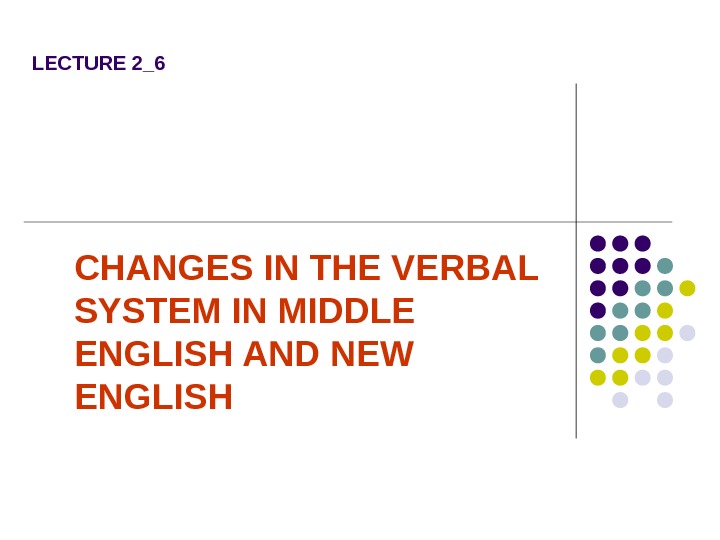
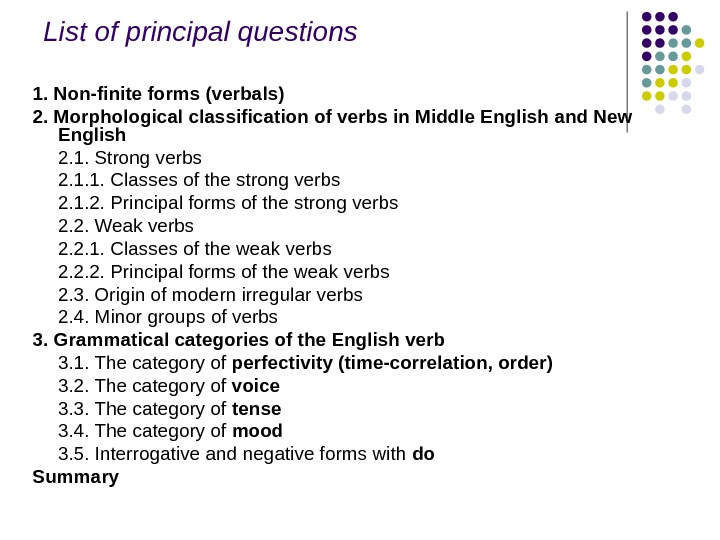


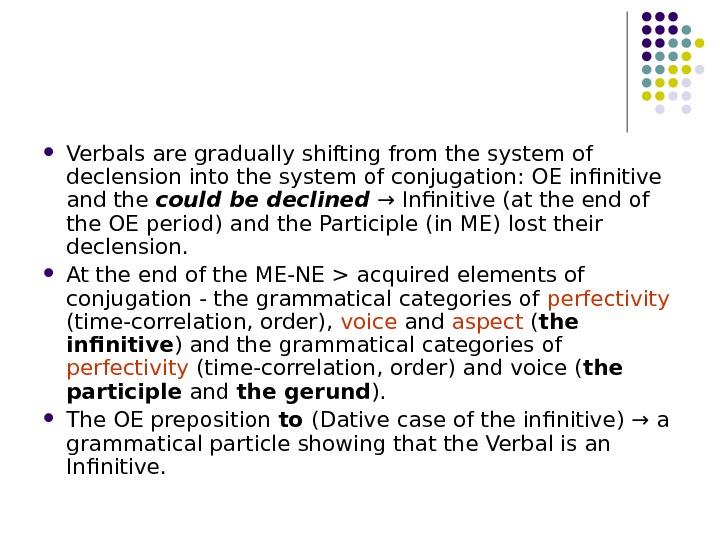



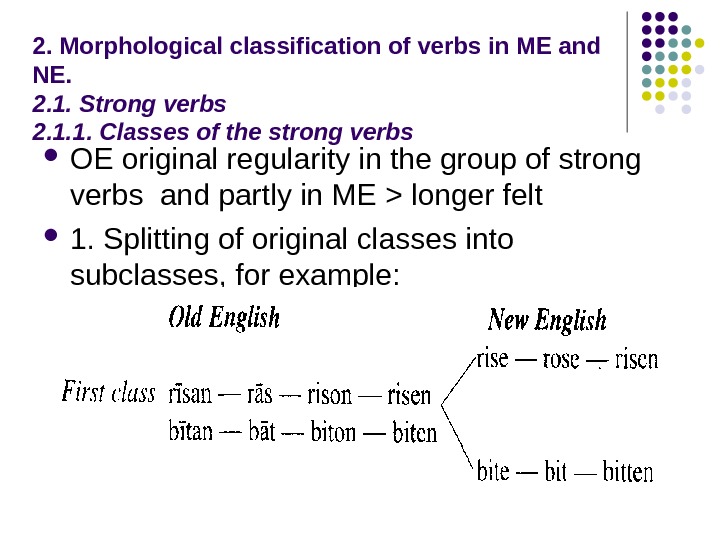

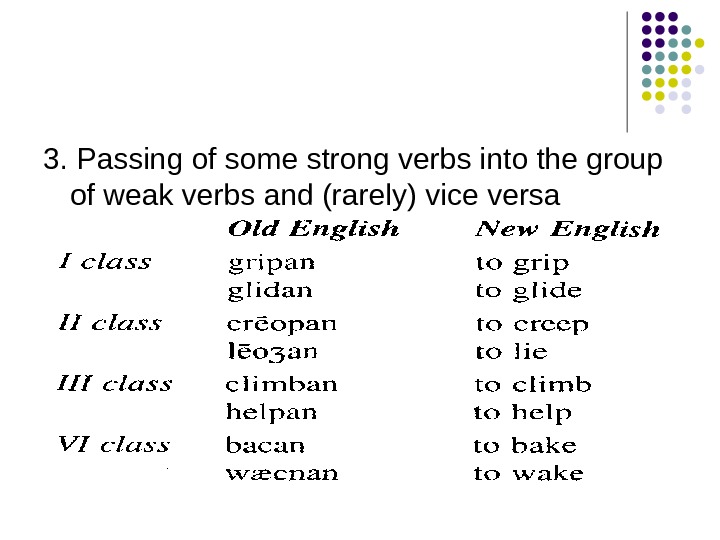
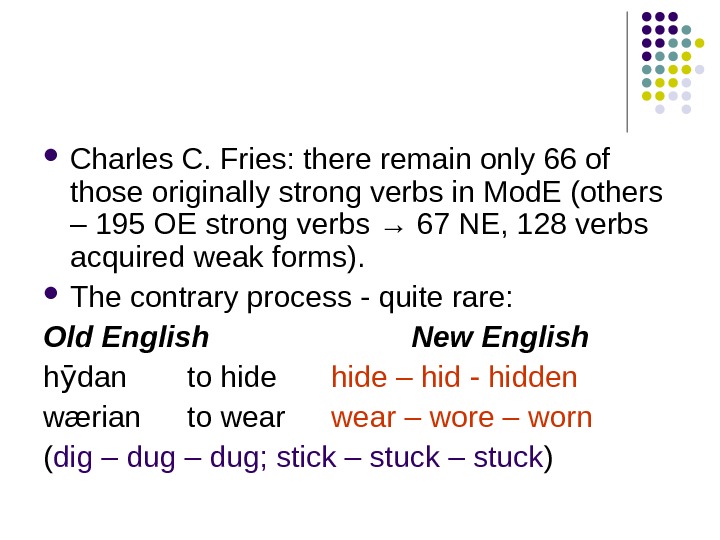


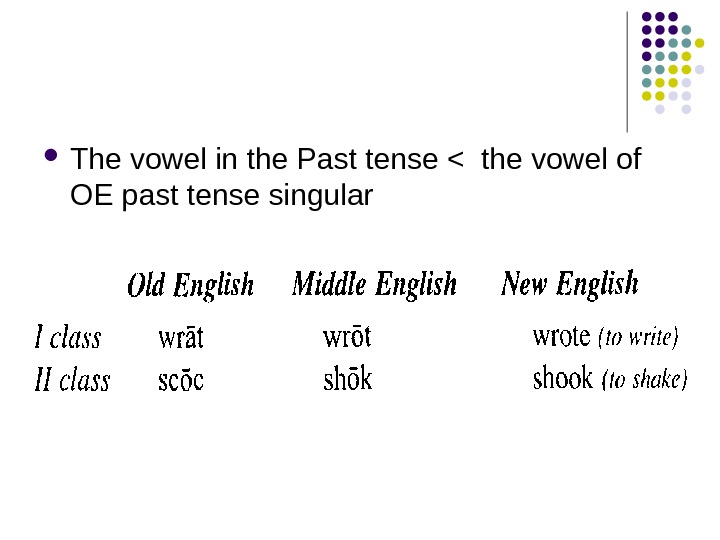
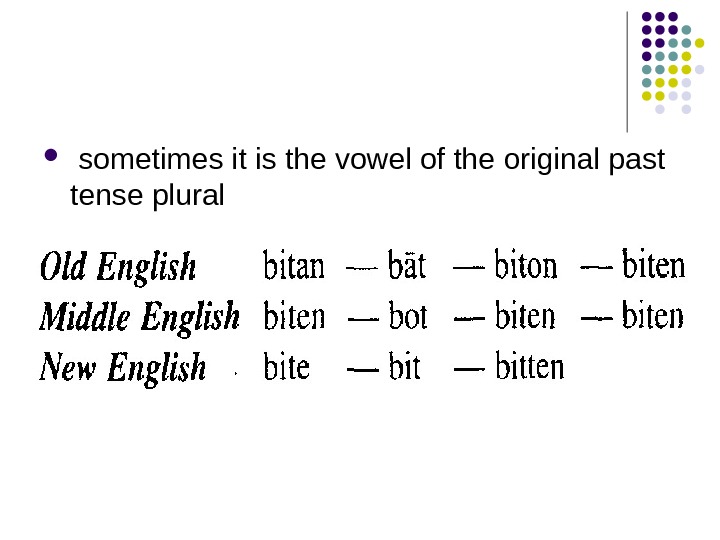

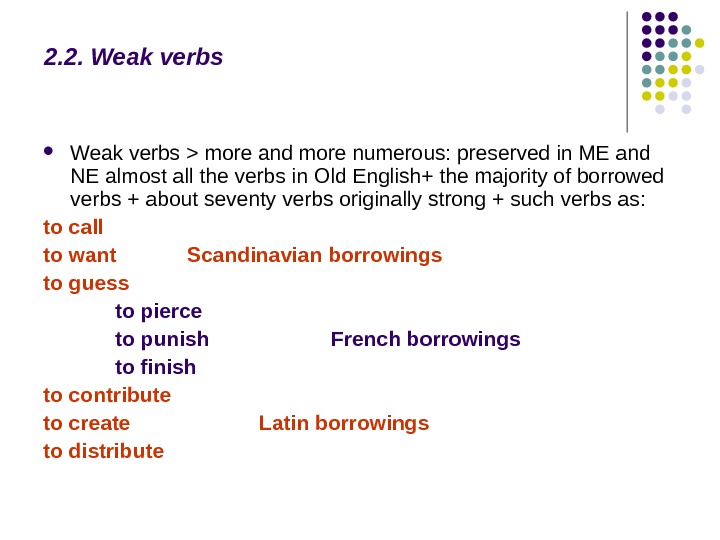
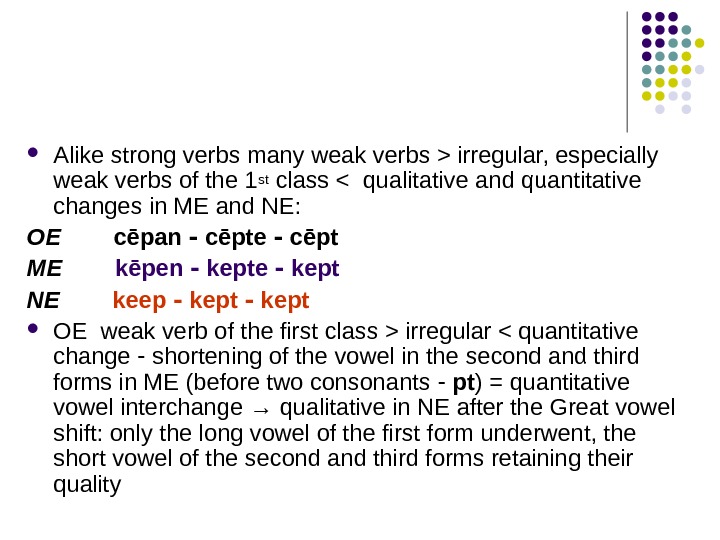
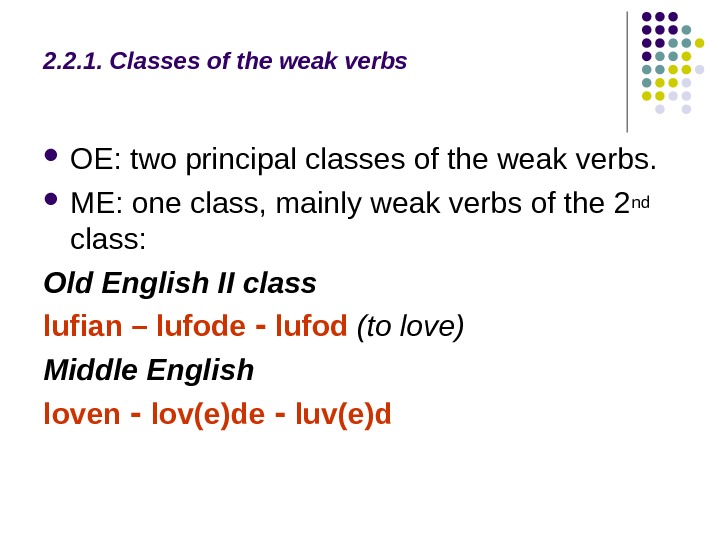




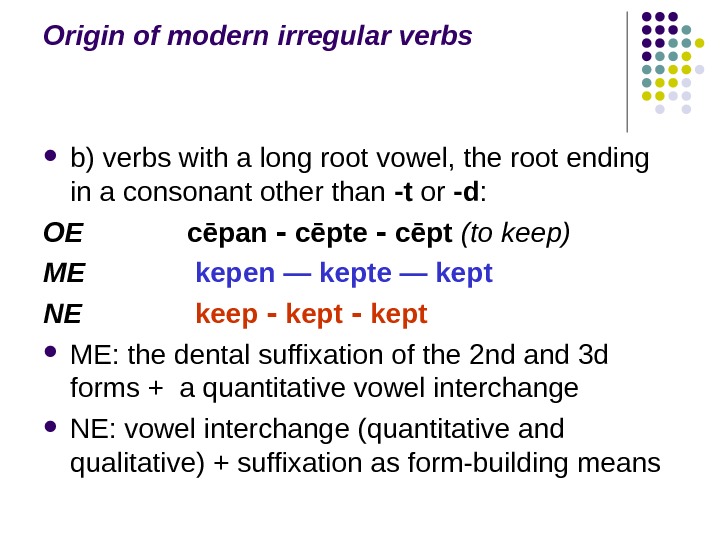
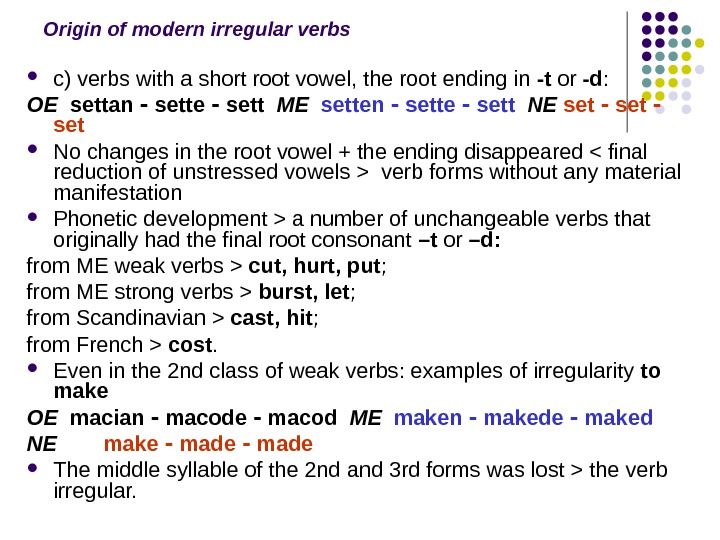
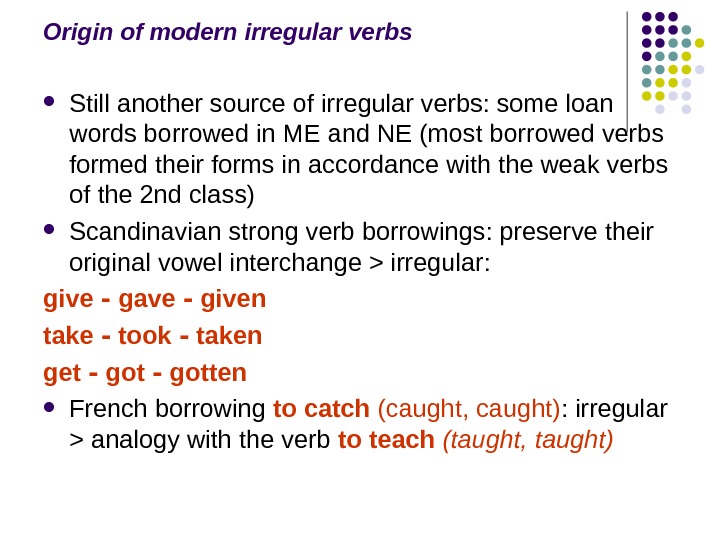

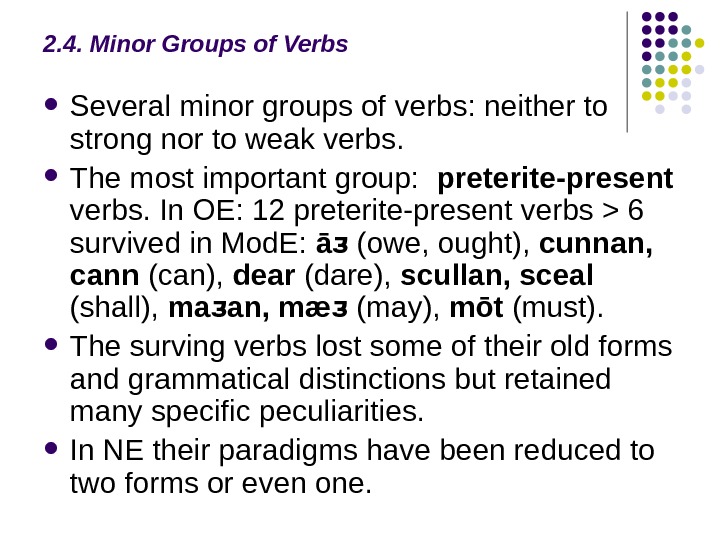


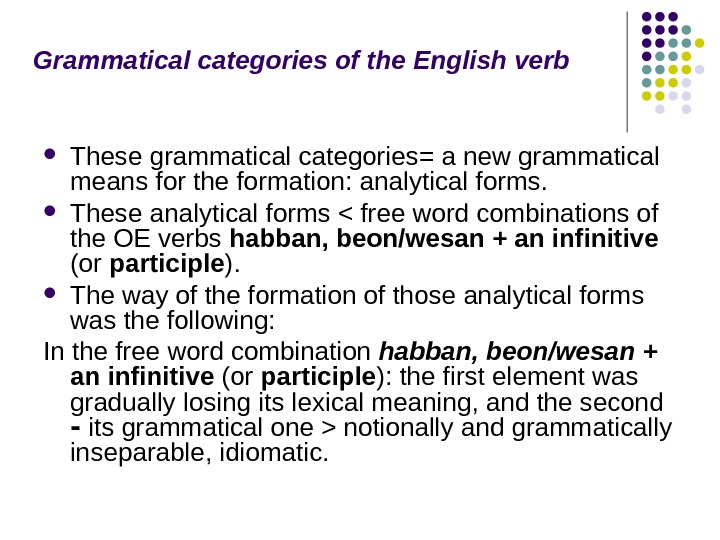




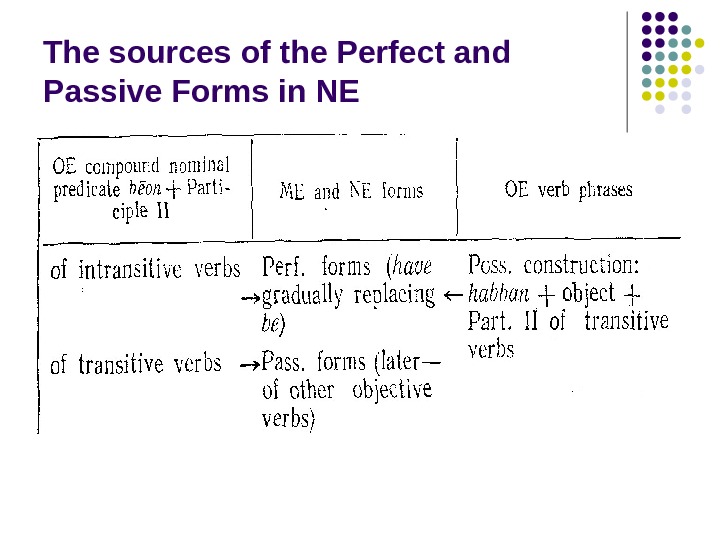
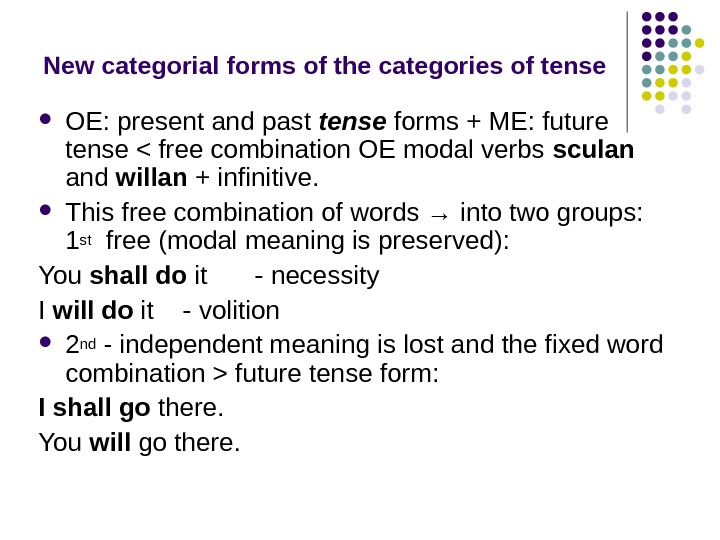
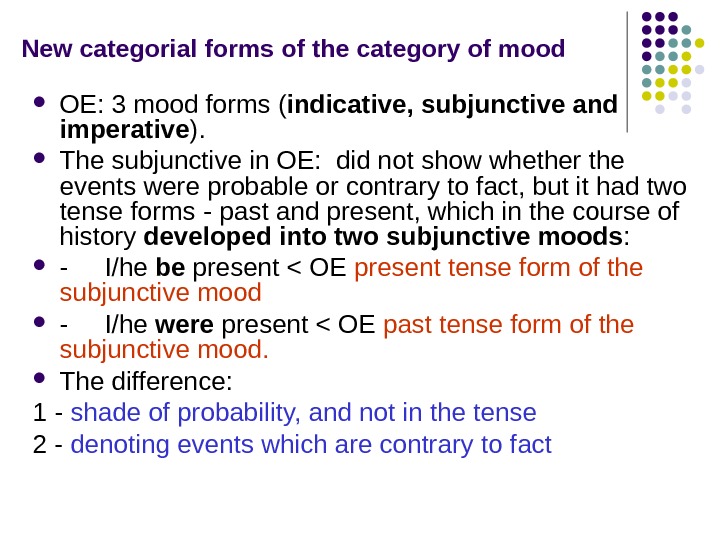


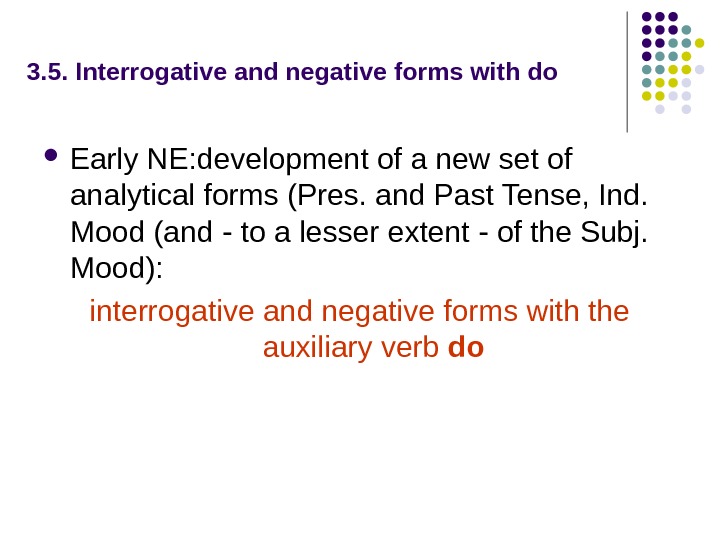
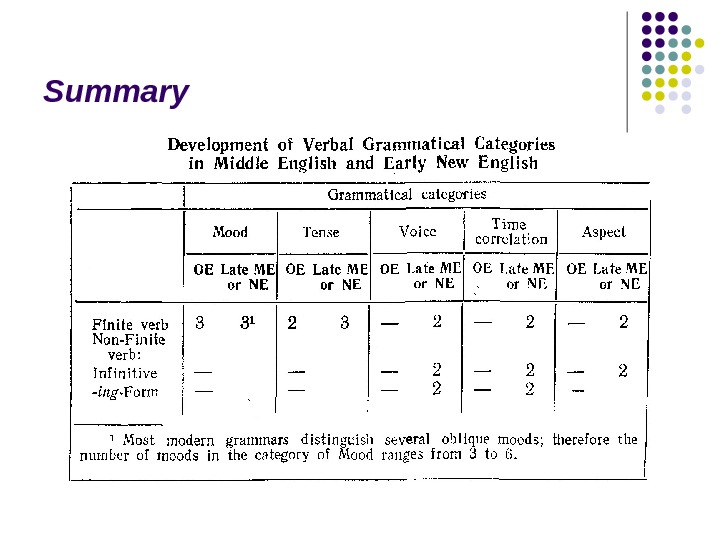
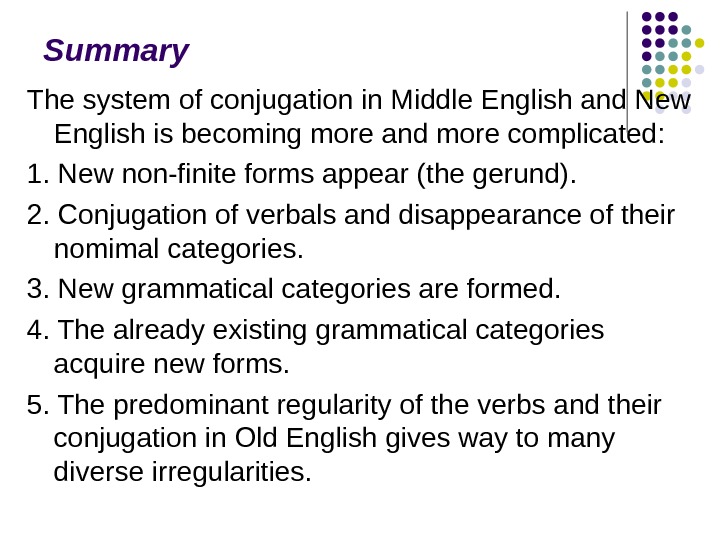
- Размер: 803 Кб
- Количество слайдов: 44
Описание презентации LECTURE 2_6 CHANGES IN THE VERBAL SYSTEM IN по слайдам
 LECTURE 2_6 CHANGES IN THE VERBAL SYSTEM IN MIDDLE ENGLISH AND NEW ENGLISH
LECTURE 2_6 CHANGES IN THE VERBAL SYSTEM IN MIDDLE ENGLISH AND NEW ENGLISH
 List of principal questions 1. Non-finite forms (verbals) 2. Morphological classification of verbs in Middle English and New English 2. 1. Strong verbs 2. 1. 1. Classes of the strong verbs 2. 1. 2. Principal forms of the strong verbs 2. 2. Weak verbs 2. 2. 1. Classes of the weak verbs 2. 2. 2. Principal forms of the weak verbs 2. 3. Origin of modern irregular verbs 2. 4. Minor groups of verbs 3. Grammatical categories of the English verb 3. 1. The category of perfectivity (time-correlation, order) 3. 2. The category of voice 3. 3. The category of tense 3. 4. The category of mood 3. 5. Interrogative and negative forms with do Summary
List of principal questions 1. Non-finite forms (verbals) 2. Morphological classification of verbs in Middle English and New English 2. 1. Strong verbs 2. 1. 1. Classes of the strong verbs 2. 1. 2. Principal forms of the strong verbs 2. 2. Weak verbs 2. 2. 1. Classes of the weak verbs 2. 2. 2. Principal forms of the weak verbs 2. 3. Origin of modern irregular verbs 2. 4. Minor groups of verbs 3. Grammatical categories of the English verb 3. 1. The category of perfectivity (time-correlation, order) 3. 2. The category of voice 3. 3. The category of tense 3. 4. The category of mood 3. 5. Interrogative and negative forms with do Summary
 The morphology of the verb: 2 distinct tendencies of development: considerable simplifying changes > affected the synthetic forms far more complicated > the growth of new, analytical forms and new grammatical categories
The morphology of the verb: 2 distinct tendencies of development: considerable simplifying changes > affected the synthetic forms far more complicated > the growth of new, analytical forms and new grammatical categories
 1. Non-finite forms (verbals) The main trends of the evolution of verbals in ME and NE: gradual loss of most nominal features (except syntactical functions) loss of case distinctions in the infinitive and of forms of agreement in the Participles growth of verbal features
1. Non-finite forms (verbals) The main trends of the evolution of verbals in ME and NE: gradual loss of most nominal features (except syntactical functions) loss of case distinctions in the infinitive and of forms of agreement in the Participles growth of verbal features
 Verbals are gradually shifting from the system of declension into the system of conjugation: OE infinitive and the could be declined → Infinitive (at the end of the OE period) and the Participle (in ME) lost their declension. At the end of the ME-NE > acquired elements of conjugation ‑ the grammatical categories of perfectivity (time-correlation, order), voice and aspect ( the infinitive ) and the grammatical categories of perfectivity (time-correlation, order) and voice ( the participle and the gerund ). The OE preposition to (Dative case of the infinitive) → a grammatical particle showing that the Verbal is an Infinitive.
Verbals are gradually shifting from the system of declension into the system of conjugation: OE infinitive and the could be declined → Infinitive (at the end of the OE period) and the Participle (in ME) lost their declension. At the end of the ME-NE > acquired elements of conjugation ‑ the grammatical categories of perfectivity (time-correlation, order), voice and aspect ( the infinitive ) and the grammatical categories of perfectivity (time-correlation, order) and voice ( the participle and the gerund ). The OE preposition to (Dative case of the infinitive) → a grammatical particle showing that the Verbal is an Infinitive.
 Mod. E: contexts where the form of the verbal is active , though the meaning is passive : The book is worth reading. The coat needs ironing. non-perfect form expresses time-correlatin, i. e. is used to express events that took place prior to the action of the finite form of the verbs: I remember doing. . . I thanked him for bringing the happy tidings. Such phenomena < reflect the previous stage — verbals were indifferent to voice and order
Mod. E: contexts where the form of the verbal is active , though the meaning is passive : The book is worth reading. The coat needs ironing. non-perfect form expresses time-correlatin, i. e. is used to express events that took place prior to the action of the finite form of the verbs: I remember doing. . . I thanked him for bringing the happy tidings. Such phenomena < reflect the previous stage — verbals were indifferent to voice and order
 OE: less verbals: Participle and Infinitive At the end of ME + a new verbal developed the ‑ Gerund The Gerund the Gerund the form (the ending -ing(e) ) — Influence of the Participle > more “verbal” in meaning.
OE: less verbals: Participle and Infinitive At the end of ME + a new verbal developed the ‑ Gerund The Gerund the Gerund the form (the ending -ing(e) ) — Influence of the Participle > more “verbal” in meaning.
 The nominal features of the gerund < verbal noun: its syntactic functions ability to be modified by a possessive pronoun or a noun in the Gen. case. the sphere of the usage of the Gerund grew: it replaced the Infinitive and the Participle in many adverbial functions; its great advantage: could be used with various prepositions
The nominal features of the gerund < verbal noun: its syntactic functions ability to be modified by a possessive pronoun or a noun in the Gen. case. the sphere of the usage of the Gerund grew: it replaced the Infinitive and the Participle in many adverbial functions; its great advantage: could be used with various prepositions
 2. Morphological classification of verbs in ME and NE. 2. 1. Strong verbs 2. 1. 1. Classes of the strong verbs OE original regularity in the group of strong verbs and partly in ME > longer felt 1. Splitting of original classes into subclasses, for example:
2. Morphological classification of verbs in ME and NE. 2. 1. Strong verbs 2. 1. 1. Classes of the strong verbs OE original regularity in the group of strong verbs and partly in ME > longer felt 1. Splitting of original classes into subclasses, for example:
 2. Some strong verbs of one class entering another class. OE verb of the 5 th class: sprecan spræc spr con sprecen‑ ‑ ǣ ‑ passed into the 5 th class in Middle English with the forms speken spak speken spoken ‑ ‑ ‑ on analogy with such verbs as stelen stal ‑ ‑ stelen stolen ‑
2. Some strong verbs of one class entering another class. OE verb of the 5 th class: sprecan spræc spr con sprecen‑ ‑ ǣ ‑ passed into the 5 th class in Middle English with the forms speken spak speken spoken ‑ ‑ ‑ on analogy with such verbs as stelen stal ‑ ‑ stelen stolen ‑
 3. Passing of some strong verbs into the group of weak verbs and (rarely) vice versa
3. Passing of some strong verbs into the group of weak verbs and (rarely) vice versa
 Charles C. Fries: there remain only 66 of those originally strong verbs in Mod. E (others – 195 OE strong verbs → 67 NE, 128 verbs acquired weak forms). The contrary process — quite rare: Old English New English h danӯ to hide – hidden‑ wærian to wear – wore – worn ( dig – dug; stick – stuck )
Charles C. Fries: there remain only 66 of those originally strong verbs in Mod. E (others – 195 OE strong verbs → 67 NE, 128 verbs acquired weak forms). The contrary process — quite rare: Old English New English h danӯ to hide – hidden‑ wærian to wear – wore – worn ( dig – dug; stick – stuck )
 4. Some weak verbs > some features of the strong verbs > weak forms along with strong forms OE weak verb scēawian ‑ Mod. E show , showed , but shown. wake – waked, wake – woken; shave – shaved (shaven)
4. Some weak verbs > some features of the strong verbs > weak forms along with strong forms OE weak verb scēawian ‑ Mod. E show , showed , but shown. wake – waked, wake – woken; shave – shaved (shaven)
 2. 1. 2. Principal forms of the strong verbs OE: 4 forms writan wrāt writon writen‑ ‑ ‑ (to write) bindan band bundon bunden ‑ ‑ ‑ (to shake) ME → NE 3 forms write — wrote — written Mod. E preterite comes either the second or from the third basic form
2. 1. 2. Principal forms of the strong verbs OE: 4 forms writan wrāt writon writen‑ ‑ ‑ (to write) bindan band bundon bunden ‑ ‑ ‑ (to shake) ME → NE 3 forms write — wrote — written Mod. E preterite comes either the second or from the third basic form
 The vowel in the Past tense < the vowel of OE past tense singular
The vowel in the Past tense < the vowel of OE past tense singular
 sometimes it is the vowel of the original past tense plural
sometimes it is the vowel of the original past tense plural
 Sometimes the vowel of the past tense form was borrowed from the form of the past participle
Sometimes the vowel of the past tense form was borrowed from the form of the past participle
 2. 2. Weak verbs > more and more numerous: preserved in ME and NE almost all the verbs in Old English+ the majority of borrowed verbs + about seventy verbs originally strong + such verbs as: to call to want Scandinavian borrowings to guess to pierce to punish French borrowings to finish to contribute to create Latin borrowings to distribute
2. 2. Weak verbs > more and more numerous: preserved in ME and NE almost all the verbs in Old English+ the majority of borrowed verbs + about seventy verbs originally strong + such verbs as: to call to want Scandinavian borrowings to guess to pierce to punish French borrowings to finish to contribute to create Latin borrowings to distribute
 Alike strong verbs many weak verbs > irregular, especially weak verbs of the 1 st class irregular < quantitative change shortening of the vowel in the second and third ‑ forms in ME (before two consonants ‑ pt ) = quantitative vowel interchange → qualitative in NE after the Great vowel shift: only the long vowel of the first form underwent, the short vowel of the second and third forms retaining their quality
Alike strong verbs many weak verbs > irregular, especially weak verbs of the 1 st class irregular < quantitative change shortening of the vowel in the second and third ‑ forms in ME (before two consonants ‑ pt ) = quantitative vowel interchange → qualitative in NE after the Great vowel shift: only the long vowel of the first form underwent, the short vowel of the second and third forms retaining their quality
 2. 2. 1. Classes of the weak verbs OE: two principal classes of the weak verbs. ME: one class, mainly weak verbs of the 2 nd class: Old English II class lufian – lufode lufod ‑ (to love) Middle English loven lov(e)de luv(e)d ‑ ‑
2. 2. 1. Classes of the weak verbs OE: two principal classes of the weak verbs. ME: one class, mainly weak verbs of the 2 nd class: Old English II class lufian – lufode lufod ‑ (to love) Middle English loven lov(e)de luv(e)d ‑ ‑
 In NE two principal groups of Mod. E verbs: regular and irregular ≠ ≈ OE strong and weak verbs.
In NE two principal groups of Mod. E verbs: regular and irregular ≠ ≈ OE strong and weak verbs.
 2. 3. Origin of modern irregular verbs OE: most verbs regular + a number of irregular ones ME: the few OE irregular verbs preserved + new irregular verbs < disappearance of the division of verbs into strong and weak, most strong verbs losing their regular pattern of conjugation and thus becoming irregular
2. 3. Origin of modern irregular verbs OE: most verbs regular + a number of irregular ones ME: the few OE irregular verbs preserved + new irregular verbs < disappearance of the division of verbs into strong and weak, most strong verbs losing their regular pattern of conjugation and thus becoming irregular
 Origin of modern irregular verbs Another source of irregular verbs < the 1 st class of weak verbs Three groups of verbs originally belonging to the 1 st class of weak verbs, which later became irregular:
Origin of modern irregular verbs Another source of irregular verbs < the 1 st class of weak verbs Three groups of verbs originally belonging to the 1 st class of weak verbs, which later became irregular:
 Origin of modern irregular verbs a) verbs with a long root vowel, the root ending in -t or -d : OE mētan mētte mētt‑ ‑ ME meten — mette — mett NE meet met ‑ ‑ ME: the root vowel of the second and third forms is shortened < the shortening of all vowels if followed by two consonants. The vowel interchange in ME is quantitative only. NE: the long root vowel in the first form now quantitative + qualitative vowel interchange in the verb.
Origin of modern irregular verbs a) verbs with a long root vowel, the root ending in -t or -d : OE mētan mētte mētt‑ ‑ ME meten — mette — mett NE meet met ‑ ‑ ME: the root vowel of the second and third forms is shortened < the shortening of all vowels if followed by two consonants. The vowel interchange in ME is quantitative only. NE: the long root vowel in the first form now quantitative + qualitative vowel interchange in the verb.
 Origin of modern irregular verbs b) verbs with a long root vowel, the root ending in a consonant other than -t or -d : OE cēpan cēpte cēpt‑ ‑ (to keep) ME kepen — kepte — kept NE keep kept ‑ ‑ ME: the dental suffixation of the 2 nd and 3 d forms + a quantitative vowel interchange NE: vowel interchange (quantitative and qualitative) + suffixation as form-building means
Origin of modern irregular verbs b) verbs with a long root vowel, the root ending in a consonant other than -t or -d : OE cēpan cēpte cēpt‑ ‑ (to keep) ME kepen — kepte — kept NE keep kept ‑ ‑ ME: the dental suffixation of the 2 nd and 3 d forms + a quantitative vowel interchange NE: vowel interchange (quantitative and qualitative) + suffixation as form-building means
 Origin of modern irregular verbs c) verbs with a short root vowel, the root ending in -t or -d : OE settan sette sett ‑ ‑ ME setten sette sett ‑ ‑ NE set ‑ ‑ set No changes in the root vowel + the ending disappeared verb forms without any material manifestation Phonetic development > a number of unchangeable verbs that originally had the final root consonant –t or –d: from ME weak verbs > cut, hurt, put ; from ME strong verbs > burst, let ; from Scandinavian > cast, hit ; from French > cost. Even in the 2 nd class of weak verbs: examples of irregularity to make OE macian macode macod ‑ ‑ ME maken makede maked ‑ ‑ NE make made ‑ ‑ The middle syllable of the 2 nd and 3 rd forms was lost > the verb irregular.
Origin of modern irregular verbs c) verbs with a short root vowel, the root ending in -t or -d : OE settan sette sett ‑ ‑ ME setten sette sett ‑ ‑ NE set ‑ ‑ set No changes in the root vowel + the ending disappeared verb forms without any material manifestation Phonetic development > a number of unchangeable verbs that originally had the final root consonant –t or –d: from ME weak verbs > cut, hurt, put ; from ME strong verbs > burst, let ; from Scandinavian > cast, hit ; from French > cost. Even in the 2 nd class of weak verbs: examples of irregularity to make OE macian macode macod ‑ ‑ ME maken makede maked ‑ ‑ NE make made ‑ ‑ The middle syllable of the 2 nd and 3 rd forms was lost > the verb irregular.
 Origin of modern irregular verbs Still another source of irregular verbs: some loan words borrowed in ME and NE (most borrowed verbs formed their forms in accordance with the weak verbs of the 2 nd class) Scandinavian strong verb borrowings: preserve their original vowel interchange > irregular: give gave given‑ ‑ take took taken ‑ ‑ get gotten ‑ ‑ French borrowing to catch (caught, caught) : irregular > analogy with the verb to teach (taught, taught)
Origin of modern irregular verbs Still another source of irregular verbs: some loan words borrowed in ME and NE (most borrowed verbs formed their forms in accordance with the weak verbs of the 2 nd class) Scandinavian strong verb borrowings: preserve their original vowel interchange > irregular: give gave given‑ ‑ take took taken ‑ ‑ get gotten ‑ ‑ French borrowing to catch (caught, caught) : irregular > analogy with the verb to teach (taught, taught)
 Origin of modern irregular verbs The number of non-standard (irregular) verbs in Mod. E is not large ≈ 200 items They constitute an important feature of the language. Most of them belong to the basic layer of the vocabulary , have a high frequency of occurrence and are widely used in word-formation and phraseological units. The significance for the grammatical system: preserved 3 principal forms > modern grammarians recognize 3 items in all English verbs despite the formal identity of the Past and Participle II
Origin of modern irregular verbs The number of non-standard (irregular) verbs in Mod. E is not large ≈ 200 items They constitute an important feature of the language. Most of them belong to the basic layer of the vocabulary , have a high frequency of occurrence and are widely used in word-formation and phraseological units. The significance for the grammatical system: preserved 3 principal forms > modern grammarians recognize 3 items in all English verbs despite the formal identity of the Past and Participle II
 2. 4. Minor Groups of Verbs Several minor groups of verbs: neither to strong nor to weak verbs. The most important group: preterite-present verbs. In OE: 12 preterite-present verbs > 6 survived in Mod. E: ā ӡ (owe, ought), cunnan, cann (can), dear (dare), scullan, sceal (shall), ma an, mæ ӡ ӡ (may), mōt (must). The surving verbs lost some of their old forms and grammatical distinctions but retained many specific peculiarities. In NE their paradigms have been reduced to two forms or even one.
2. 4. Minor Groups of Verbs Several minor groups of verbs: neither to strong nor to weak verbs. The most important group: preterite-present verbs. In OE: 12 preterite-present verbs > 6 survived in Mod. E: ā ӡ (owe, ought), cunnan, cann (can), dear (dare), scullan, sceal (shall), ma an, mæ ӡ ӡ (may), mōt (must). The surving verbs lost some of their old forms and grammatical distinctions but retained many specific peculiarities. In NE their paradigms have been reduced to two forms or even one.
 2. 4. Minor Groups of Verbs Several anomalous verbs with irregular forms ( willan, dōn ) 2 suppletive verbs ān ӡ (go) and bēon (be) will and shall weakened their lexical meanings and changed into auxiliaries go remained a suppletive verb ME ben (NE be) inherited its suppletive forms from the OE and more remote periods of history
2. 4. Minor Groups of Verbs Several anomalous verbs with irregular forms ( willan, dōn ) 2 suppletive verbs ān ӡ (go) and bēon (be) will and shall weakened their lexical meanings and changed into auxiliaries go remained a suppletive verb ME ben (NE be) inherited its suppletive forms from the OE and more remote periods of history
 3. Grammatical categories of the English verb OE: verb had 4 categories: person, number, tense and mood. ME and NE + 3 more grammatical categories – perfectivity (order, time-correlation), voice and aspect.
3. Grammatical categories of the English verb OE: verb had 4 categories: person, number, tense and mood. ME and NE + 3 more grammatical categories – perfectivity (order, time-correlation), voice and aspect.
 Grammatical categories of the English verb These grammatical categories= a new grammatical means for the formation: analytical forms. These analytical forms notionally and grammatically inseparable, idiomatic.
Grammatical categories of the English verb These grammatical categories= a new grammatical means for the formation: analytical forms. These analytical forms notionally and grammatically inseparable, idiomatic.
 3. 1. The category of perfectivity (time-correlation, order) the oldest, formed already in ME < OE free combination habban + past participle
3. 1. The category of perfectivity (time-correlation, order) the oldest, formed already in ME < OE free combination habban + past participle
 The category of perfectivity (time-correlation, order) The same idea of perfectivity (time-correlation, order): still expressed to be + participle 2 < OE beon + past participle: This gentleman is happily arrived. Now he is gone.
The category of perfectivity (time-correlation, order) The same idea of perfectivity (time-correlation, order): still expressed to be + participle 2 < OE beon + past participle: This gentleman is happily arrived. Now he is gone.
 3. 2. The category of voice appeared out of the free combination of weorpan (beon) + past participle: OE he wēarþ ofslæ en ӡ (he was slain ) ME engendered is the flour (the flower is generated [born])
3. 2. The category of voice appeared out of the free combination of weorpan (beon) + past participle: OE he wēarþ ofslæ en ӡ (he was slain ) ME engendered is the flour (the flower is generated [born])
 The category of aspect formed in ME < free combination ben (beon) + present participle: Singinge hē was . . . al the dai (he was singing all the day).
The category of aspect formed in ME < free combination ben (beon) + present participle: Singinge hē was . . . al the dai (he was singing all the day).
 The sources of the Perfect and Passive Forms in N
The sources of the Perfect and Passive Forms in N
 New categorial forms of the categories of tense OE: present and past tense forms + ME: future tense future tense form: I shall go there. You will go there.
New categorial forms of the categories of tense OE: present and past tense forms + ME: future tense future tense form: I shall go there. You will go there.
 New categorial forms of the category of mood OE: 3 mood forms ( indicative, subjunctive and imperative ). The subjunctive in OE: did not show whether the events were probable or contrary to fact, but it had two tense forms past and present, which in the course of ‑ history developed into two subjunctive moods : — I/he be present < OE present tense form of the subjunctive mood — I/he were present < OE past tense form of the subjunctive mood. The difference: 1 — shade of probability, and not in the tense 2 — denoting events which are contrary to fact
New categorial forms of the category of mood OE: 3 mood forms ( indicative, subjunctive and imperative ). The subjunctive in OE: did not show whether the events were probable or contrary to fact, but it had two tense forms past and present, which in the course of ‑ history developed into two subjunctive moods : — I/he be present < OE present tense form of the subjunctive mood — I/he were present < OE past tense form of the subjunctive mood. The difference: 1 — shade of probability, and not in the tense 2 — denoting events which are contrary to fact
 New categorial forms of the category of mood end of ME and the beginning of NE + 2 more subjunctive mood forms (analytical form building means): I/he should be present ‑ to show events which are probable, though problematic I should be present he would be present ‑ to show imaginary events, contrary to fact Here should and would are the subjunctive mood forms of OE sculan and willan
New categorial forms of the category of mood end of ME and the beginning of NE + 2 more subjunctive mood forms (analytical form building means): I/he should be present ‑ to show events which are probable, though problematic I should be present he would be present ‑ to show imaginary events, contrary to fact Here should and would are the subjunctive mood forms of OE sculan and willan
 The Sources of the NE forms of the Subjunctive Mood
The Sources of the NE forms of the Subjunctive Mood
 3. 5. Interrogative and negative forms with do Early NE: development of a new set of analytical forms (Pres. and Past Tense, Ind. Mood (and to a lesser extent of the Subj. ‑ ‑ Mood): interrogative and negative forms with the auxiliary verb do
3. 5. Interrogative and negative forms with do Early NE: development of a new set of analytical forms (Pres. and Past Tense, Ind. Mood (and to a lesser extent of the Subj. ‑ ‑ Mood): interrogative and negative forms with the auxiliary verb do
 Summary
Summary
 Summary The system of conjugation in Middle English and New English is becoming more and more complicated: 1. New non-finite forms appear (the gerund). 2. Conjugation of verbals and disappearance of their nomimal categories. 3. New grammatical categories are formed. 4. The already existing grammatical categories acquire new forms. 5. The predominant regularity of the verbs and their conjugation in Old English gives way to many diverse irregularities.
Summary The system of conjugation in Middle English and New English is becoming more and more complicated: 1. New non-finite forms appear (the gerund). 2. Conjugation of verbals and disappearance of their nomimal categories. 3. New grammatical categories are formed. 4. The already existing grammatical categories acquire new forms. 5. The predominant regularity of the verbs and their conjugation in Old English gives way to many diverse irregularities.

